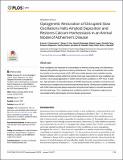| dc.contributor.author | Kastanenka, Ksenia V. | en_US |
| dc.contributor.author | Hou, Steven S. | en_US |
| dc.contributor.author | Shakerdge, Naomi | en_US |
| dc.contributor.author | Logan, Robert | en_US |
| dc.contributor.author | Feng, Danielle | en_US |
| dc.contributor.author | Wegmann, Susanne | en_US |
| dc.contributor.author | Chopra, Vanita | en_US |
| dc.contributor.author | Hawkes, Jonathan M. | en_US |
| dc.contributor.author | Chen, Xiqun | en_US |
| dc.contributor.author | Bacskai, Brian J. | en_US |
| dc.date.accessioned | 2017-03-28T23:50:55Z | |
| dc.date.issued | 2017 | en_US |
| dc.identifier.citation | Kastanenka, Ksenia V., Steven S. Hou, Naomi Shakerdge, Robert Logan, Danielle Feng, Susanne Wegmann, Vanita Chopra, Jonathan M. Hawkes, Xiqun Chen, and Brian J. Bacskai. 2017. “Optogenetic Restoration of Disrupted Slow Oscillations Halts Amyloid Deposition and Restores Calcium Homeostasis in an Animal Model of Alzheimer’s Disease.” PLoS ONE 12 (1): e0170275. doi:10.1371/journal.pone.0170275. http://dx.doi.org/10.1371/journal.pone.0170275. | en |
| dc.identifier.issn | | en |
| dc.identifier.uri | http://nrs.harvard.edu/urn-3:HUL.InstRepos:31731823 | |
| dc.description.abstract | Slow oscillations are important for consolidation of memory during sleep, and Alzheimer’s disease (AD) patients experience memory disturbances. Thus, we examined slow oscillation activity in an animal model of AD. APP mice exhibit aberrant slow oscillation activity. Aberrant inhibitory activity within the cortical circuit was responsible for slow oscillation dysfunction, since topical application of GABA restored slow oscillations in APP mice. In addition, light activation of channelrhodopsin-2 (ChR2) expressed in excitatory cortical neurons restored slow oscillations by synchronizing neuronal activity. Driving slow oscillation activity with ChR2 halted amyloid plaque deposition and prevented calcium overload associated with this pathology. Thus, targeting slow oscillatory activity in AD patients might prevent neurodegenerative phenotypes and slow disease progression. | en |
| dc.language.iso | en_US | en |
| dc.publisher | Public Library of Science | en |
| dc.relation.isversionof | doi:10.1371/journal.pone.0170275 | en |
| dc.relation.hasversion | http://www.ncbi.nlm.nih.gov/pmc/articles/PMC5257003/pdf/ | en |
| dash.license | LAA | en_US |
| dc.subject | Experimental Organism Systems | en |
| dc.subject | Model Organisms | en |
| dc.subject | Mouse Models | en |
| dc.subject | Animal Models | en |
| dc.subject | Biology and Life Sciences | en |
| dc.subject | Biochemistry | en |
| dc.subject | Neurochemistry | en |
| dc.subject | Neurotransmitters | en |
| dc.subject | Gamma-Aminobutyric Acid | en |
| dc.subject | Neuroscience | en |
| dc.subject | Medicine and Health Sciences | en |
| dc.subject | Diagnostic Medicine | en |
| dc.subject | Signs and Symptoms | en |
| dc.subject | Amyloid Plaques | en |
| dc.subject | Pathology and Laboratory Medicine | en |
| dc.subject | Cell Biology | en |
| dc.subject | Cellular Types | en |
| dc.subject | Animal Cells | en |
| dc.subject | Neurons | en |
| dc.subject | Cellular Neuroscience | en |
| dc.subject | Neuronal Dendrites | en |
| dc.subject | Neurites | en |
| dc.subject | Mental Health and Psychiatry | en |
| dc.subject | Dementia | en |
| dc.subject | Alzheimer Disease | en |
| dc.subject | Neurology | en |
| dc.subject | Neurodegenerative Diseases | en |
| dc.subject | Imaging Techniques | en |
| dc.subject | Neuroimaging | en |
| dc.subject | Calcium Imaging | en |
| dc.subject | Brain Mapping | en |
| dc.subject | Optogenetics | en |
| dc.subject | Bioassays and Physiological Analysis | en |
| dc.subject | Neurophysiological Analysis | en |
| dc.title | Optogenetic Restoration of Disrupted Slow Oscillations Halts Amyloid Deposition and Restores Calcium Homeostasis in an Animal Model of Alzheimer’s Disease | en |
| dc.type | Journal Article | en_US |
| dc.description.version | Version of Record | en |
| dc.relation.journal | PLoS ONE | en |
| dash.depositing.author | Kastanenka, Ksenia V. | en_US |
| dc.date.available | 2017-03-28T23:50:55Z | |
| dc.identifier.doi | 10.1371/journal.pone.0170275 | * |
| dash.contributor.affiliated | Hou, Steven | |
| dash.contributor.affiliated | Kastanenka, Ksenia | |
| dash.contributor.affiliated | Chen, Xiqun | |
| dash.contributor.affiliated | Bacskai, Brian | |
| dash.contributor.affiliated | Chopra, Vanita | |
| dash.contributor.affiliated | Wegmann, Susanne | |


